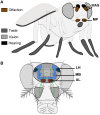The smell of love in Drosophila
- PMID: 23576993
- PMCID: PMC3617446
- DOI: 10.3389/fphys.2013.00072
The smell of love in Drosophila
Abstract
Odors are key sensory signals for social communication and food search in animals including insects. Drosophila melanogaster, is a powerful neurogenetic model commonly used to reveal molecular and cellular mechanisms involved in odorant detection. Males use olfaction together with other sensory modalities to find their mates. Here, we review known olfactory signals, their related olfactory receptors, and the corresponding neuronal architecture impacting courtship. OR67d receptor detects 11-cis-Vaccenyl Acetate (cVA), a male specific pheromone transferred to the female during copulation. Transferred cVA is able to reduce female attractiveness for other males after mating, and is also suspected to decrease male-male courtship. cVA can also serve as an aggregation signal, maybe through another OR. OR47b was shown to be activated by fly odors, and to enhance courtship depending on taste pheromones. IR84a detects phenylacetic acid (PAA) and phenylacetaldehyde (PA). These two odors are not pheromones produced by flies, but are present in various fly food sources. PAA enhances male courtship, acting as a food aphrodisiac. Drosophila males have thus developed complementary olfactory strategies to help them to select their mates.
Keywords: Drosophila; courtship; nervous system; olfaction; receptor.
Figures


References
-
- Barata A., Campo E., Malfeito-Ferreira M., Loureiro V., Cacho J., Ferreira V. (2011). Analytical and sensorial characterization of the aroma of wines produced with sour rotten grapes using GC-O and GC-MS: identification of key aroma compounds. J. Agric. Food Chem. 59, 2543–2553 10.1021/jf104141f - DOI - PubMed
-
- Bartelt R. J., Schaner A. M., Jackson L. L. (1985). Cis-Vaccenyl acetate as an aggregation pheromone in Drosophila melanogaster. J. Chem. Ecol. 11, 1747–1756 - PubMed
Grants and funding
LinkOut - more resources
Full Text Sources
Other Literature Sources
Molecular Biology Databases

